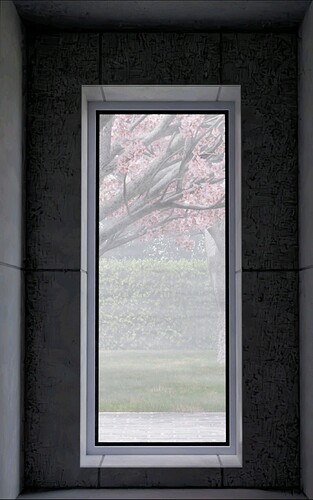Hello there! I hope somebody can help me…
The first image was rendered with about 50-70 samples. Noise threshold at 0.1 and optix denoiser.
Looks quite good, only the hedge in the background looks very washed out.
The second image was rendered with about 700-1000 samples. Threshold at 0.02 and also optix denoiser.
The hedge looks a bit sharper, but now there are many black dots on the tile texture which the denoiser completely smears.
Can anyone please explain why this is the case? I have rendered a section of the image with 10000 samples to check. I know, ridiculously high samples but the black dots still remained.
Why does an image with less than 100 samples look better than one with 1000 samples?
More light from outside doesn’t help either. I increased the intensity by a factor of 10. This quadrupled my render time and the black dots were still there.
Maybe someone can help me with this problem or has had the same thing before. I don’t have the problem in bright rooms. Of course, more light in the room could help, but I want to keep the scene dark and do without additional lights.
Thank you very much in advance.
Sry, i only post the weird result.
1 Like
First off, welcome to the community, @1180s_Studio! What you’ve come across is something really difficult to get right using a path tracer like Cycles. Noise from indirect lighting happens because we don’t have unlimited light bounces and there’s still the random chance that a sample terminates before it reaches a light source.
First, I’d recommend taking a look at the Blender Cycles manual page about reducing noise, specifically read about “light portals”:
https://docs.blender.org/manual/en/latest/render/cycles/optimizations/reducing_noise.html#light-portals
Here’s a taste:
When rendering a daylight indoor scene where most of the light is coming in through a window or door opening, it is difficult for the integrator to find its way to them.
I’m also not sure if you used a real glass shader for your window pane, but if so, you should read the section on that page called “Glass and Transparent Shadows”.
Take a look at those and let us know if they work for you!
2 Likes
If there is glass, since I don’t see anything reflecting in it you could remove it or turn off shadow rays on the glass object.
Use nishita sky to get a base line of how bright the real sunlight would be. Before reducing strength of light, first adjust exposure in color management settings just as you would adjust exposure of a camera in the real world. Then tweak the lighting to get your overcast look.
If you switch from nishita to area lights or HDRI, just remember how strong nishita was and make your replacement lights just as strong so that they work with the exposure you set when using nishita.
Disable indirect light clamping.
If there is still a problem, put an area light behind the camera pointing at the problem area and set to a very low value. The tiniest bit of direct light is a lot more reliable than hoping you get enough lucky-bounce light
2 Likes
Hello everybody! Thanks for your help. I found something weird in this special scene.
If i put the noise threshold from 0.01 to 0.001, blender “does bot” increase my render time. But the black spots are gone.
I cannot explain why. But the next time i’ll try your tipps and hope for better results.
